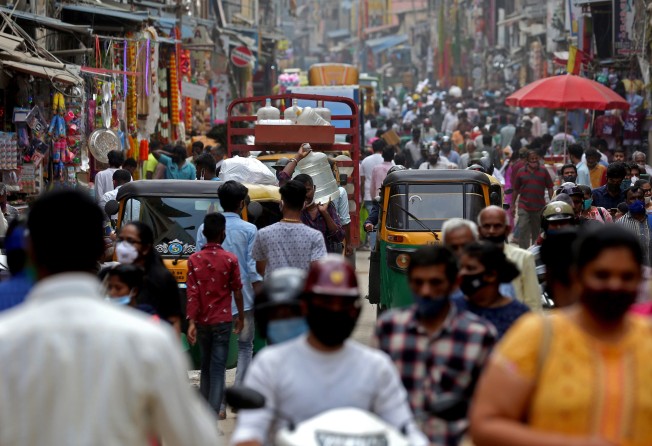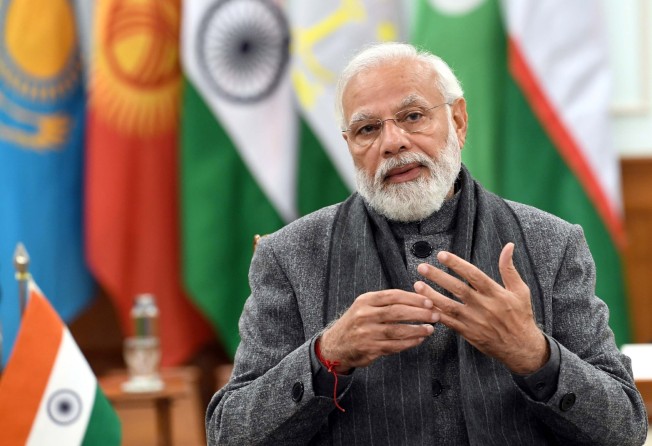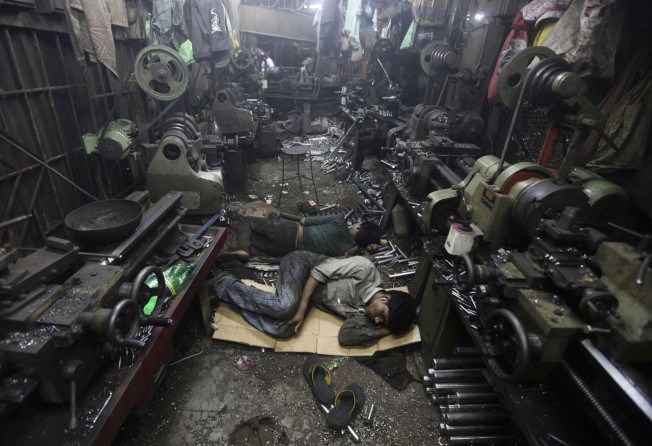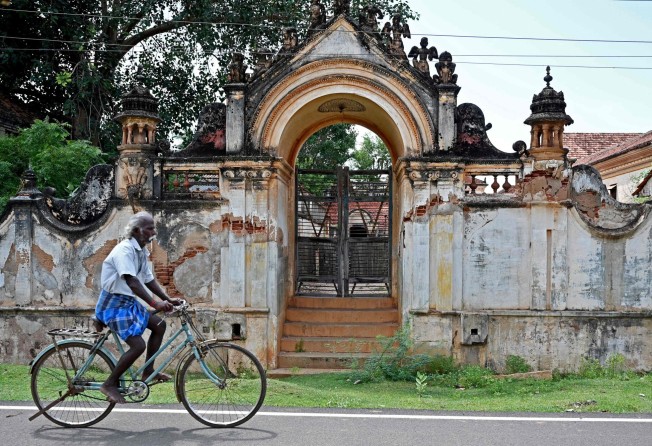India’s US$530 billion budget and China-beating 9.2 per cent growth target camouflage struggles with inflation, unemployment
- Eye-catching plans for repairing a pandemic-scarred economy have cheered the stock market, but analysts say those who need help the most will be left wanting
- While PM Modi goes big on infrastructure, he has cut outlays to the rural poor even as elections loom. Meanwhile, rising oil prices make his target look ‘optimistic’ at best

Arjun Kumar, 42, was making good money as a driver for a New Delhi couple who had employed him for years. But when Covid-19 struck two years ago, they let him go and, since then, he hasn’t found another steady job.
“Everybody’s working from home, they don’t need someone regularly,” Kumar said. He used to send money home to his wife, three children and parents in his home village in the eastern state of Bihar. Now, he can scarcely support himself with the few driving jobs he gets.
Last week, India announced in its new budget a go-for-growth spending spree to repair its pandemic-scarred economy. The government’s 40 trillion rupee (US$530 billion) budget is targeting a world-beating 9.2 per cent economic expansion for this fiscal year ending in March and 8 to 8.5 per cent growth for next year, fired by huge infrastructure outlays.
The budget has cheered the stock market, but for the legions of unemployed or semi-employed workers, the government’s big plans won’t make any kind of immediate difference.
While Finance Minister Nirmala Sitharaman is betting infrastructure spending can have a multiplier effect on job creation, consumption and drive overall prosperity, the reality is it will take time for benefits to trickle down to those who need it most, economists say.
The government’s budget has held back on big-bang policies to improve the lot of India’s so-called “common man” and put money in the pockets of the poorest. This is all the more unusual given looming elections in five states – seen as an important popularity test of the ruling Bharatiya Janata Party (BJP) midway through its second term.
“The government pontificating ‘India will be the fastest-growing economy in the world’ is a chimera,” said Sanjay Jha, an economics commentator who formerly played a key role in the main opposition Congress party but has stepped away from active politics. “[It] camouflages the real ‘Third World’ issues that still plague us, such as unemployment.”

Just as Prime Minister Narendra Modi’s government has gone heavy on infrastructure spending, hiking it by a massive 35 per cent to US$100 billion, it has reduced outlays on rural jobs, food and fertiliser subsidies. In the weeks leading up to the budget, various economists highlighted mounting unemployment, falling household earnings and glaring economic inequality as problems that needed to be tackled in the budget.
Three Covid-19 waves have undone decades of economic progress and driven tens of millions of Indians back into poverty, analysts say.
Also, consumer demand, crucial to driving growth, “is still weak and not broad-based”, said India Ratings principal economist Sunil Kumar Sinha, due to uncertainty and hardship caused by the pandemic.
“Job losses and lower earnings over recurrent waves, and the pressure on medical expenditure during the pandemic, have taken a toll on household savings,” added Crisil rating agency chief economist D.K. Joshi.
“Those suffering income losses are clearly consuming less, and those who used up their savings are prioritising rebuilding buffers,” he added. Inflation had become a major worry and was “eroding purchasing power”.
Even as the consumer price index remains within the central bank’s accepted range, wholesale price inflation is running at nearly 14 per cent.
There is also a string of significant caveats attached to the government’s upbeat growth outlook. Next year’s growth projection is based on many factors outside its control, including assumptions of no more pandemic-related economic disruptions, a “normal” monsoon, orderly withdrawal of rate hikes by global central banks, falling oil prices and reduced global supply chain disruptions, according to the government’s annual Economic Survey.
“There are downside risks to the growth outlook of 8 to 8.5 per cent largely from external factors – high crude prices and reversal of monetary policy by systemically important central banks [to combat inflation],” said Joshi, calling the forecast “optimistic”. Indeed with the oil market trading at its strongest in years, talk of a return to US$100 barrel oil is growing daily (the global Brent benchmark is currently at US$93.27).

Weaning dependence off China
India’s growth projections are higher than China’s 8.1 per cent expansion in calendar 2021 and projected slower 5.5 to 6 per cent growth in 2022, as the Chinese economy faces headwinds from a property downturn and efforts to curb Omicron.
But even with India’s forecast 9.2 per cent growth in 2020-21, the economy will only be recovering from a low base as GDP shrank 6.6 per cent last year (China eked out 2.2 per cent growth in 2020). The Indian economy actually had started slowing before the pandemic, expanding by just 4 per cent in 2019-20. The government believes real recovery will begin with its forecast 8 to 8.5 per cent growth in the next fiscal year and describes the budget as a “blueprint” for a 25 year economic “golden age” that will take India to its independence centenary. Sitharaman said India’s growth would be “driven by seven engines, namely roads, railways, airports, ports, mass transport, waterways and logistics infrastructure”.
The spending programme also offers subsidies to solar-panel-makers to wean India away from using cheaper Chinese equipment that currently dominates the domestic market. Ever since the Sino-Indian military border stand-off in 2020, India has been seeking to slash its purchases from Chinese factories.
But instead, Chinese government data shows bilateral trade jumped 43 per cent year-on-year to a record US$125.6 billion in 2021. India’s imports from China accounted for US$97.5 billion of the total, up 46 per cent from US$66.7 billion in 2020 as purchases of everything from laptops and printed circuit boards to automobile components climbed. India’s exports to China also jumped to a record high of $28.1 billion in 2021, up 35 per cent from US$20.9 billion in 2020.
There are various reasons why India’s imports have kept growing despite New Delhi’s desire to reduce its dependence on China.
During the past 20 years, China has built up a solid position as the world’s factory, producing goods at much cheaper prices than anywhere else. As a result, Indian and global companies have become used to finding the best deals in China, analysts say.
And, of course, China has had an edge in supplying the world during the pandemic because it has been able to keep manufacturing around the clock. By stamping out Covid-19 outbreaks with extremely stringent restrictions early in the pandemic’s course, Chinese exporters were able to resume most normal business in the first half of 2020.
As a result, China was able to keep production in its factories going at full-tilt when output was stalling in India and in other parts of the world due to shutdowns and other disruptions.
The Indian government is cranking up schemes to boost the domestic output of electronic parts and other goods, but that could take at least three to five years to have an impact, experts say.
Only in sectors like mobile phones where manufacturers already have production facilities and huge sales, are there likely to be short-term results. But India is not alone in having difficulties curbing purchases of Chinese goods. Chinese exports to the United States climbed 30 per cent in 2021 from a year earlier to US$57.4 billion while Chinese imports from the US leapt nearly 17 per cent to US$15.4 billion.

Preoccupation with K-shaped recovery
What has dominated discussions this past week about the budget though are fears of a “K-shaped recovery”, in which rich Indians get richer and the poor get poorer. Economists point to how spending on the flagship Mahatma Gandhi National Rural Employment Generation Act (MGNREGA), the vast rural scheme providing 100 days of work to each rural household, will shrink.
Allocations to the programme, known as the world’s biggest social security system, have been cut by 25 per cent to 730 billion rupees (US$9.7 billion) from 980 billion rupees in the previous year at a time when demand for the scheme had been increasing due to labourers returning home from big cities due to Covid-19. The rural jobs scheme “remains the only lifeline” for a vast section of workers, Joshi said. The farmers’ fertiliser subsidy has also been cut.
Pre-budget calls for an urban employment plan like MNREGA to help daily wage workers also went unheeded.
“Our effort is to ensure jobs, not doles,” the finance minister explained last weekend while saying that if “demand rises” for the rural jobs scheme, “we will raise funds”. Income tax slabs also remained untouched.
Rajesh Shukla, chief executive of the People’s Research on India’s Consumer Economy (PRICE), a Mumbai-based think tank, said India needed an economics policy “that addresses the two ends of the ‘K’ spectrum and [to do] a lot more thinking on how to build the bridge between the two”.
According to the latest World Inequality Report, the top one per cent of India’s 1.4 billion population held 22 per cent of the national income in 2021 while the top 10 per cent accounted for 57 per cent. In contrast, the bottom 50 per cent has just 13 per cent of the national income. Also, even after the coronavirus crisis exposed the fault lines in India’s chronically underfunded health care system, the government announced no new initiatives to fix it.
Dr Alok Roy, chairman of the Medica Group of Hospitals – an eastern India hospital chain – said when the country was struggling with a tsunami of Delta variant cases during last year’s second wave of infections, “a silver lining was the belief that there would be a big push” on health care spending. “Unfortunately, we haven’t heard much,” he said.
India’s health care spending, combining central and state governments, is around 1.4 per cent of GDP, among the world’s lowest.

There are bright spots in the economy with many companies turning in strong earnings. The benchmark Sensex 30 index of stocks leapt by close to 22 per cent in 2021, outperforming the Shanghai Composite Index which gained 4.8 per cent, and many other bourses worldwide. The government says India’s total exports are on track to hit its US$650 billion target this year, up from US$500 billion last year.
India’s flagship pharmaceutical firms are enjoying a boom; Infosys, Tata Consultancy Services and others in the IT sector are experiencing roaring sales thanks to pandemic-led digitisation; there has been a surge in the number of unicorns (companies worth over US$1 billion) and various financial sector players are doing well. But they do not provide sufficient jobs to soak up the vast number of unemployed, especially the young.
Every month, one million young Indians join the labour market and there are mounting worries that India’s vast young labour force, which it touts as its “demographic dividend”, (the median age is 28 in India compared to 37 in China and the US and more than two-thirds of its 1.4 billion people are of working age), will turn into a “demographic disaster”.
In a sign of the desperation over lack of work, a staggering 10 million people recently applied for 35,000 jobs with India’s railways. In Bihar last month, there were three days of riots over unemployment that spread to next-door Uttar Pradesh, India’s most populous state that goes to the polls next month.
To rating agencies’ dismay, India is also doubling down on spending at the expense of fiscal restraint. The government plans a record US$200 billion in borrowing to fund its dash for growth and its fiscal deficit next year will be a gaping 6.4 per cent, one of the widest of the major economies.
The situation led Indian economic commentator TN Ninan to note in a weekend column in the Business Standard newspaper: “The question to ask today is whether such growth should be the sole measure of success. What about employment, poverty, the environment, education, and health?”